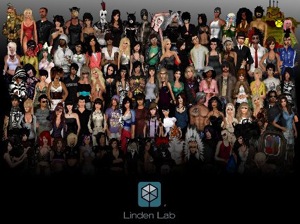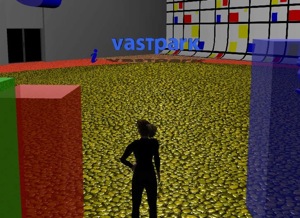1. Globe and Mail (Canada) – For God’s sake, get a Second Life (or not). “Lois King has an avatar. Her avatar is a tall, shapely blonde who lives in a virtual world called Second Life. She wears a snappy business suit, which is appropriate because she teaches serious courses in finance at York University in Toronto. She teaches traditional classroom courses, as well as distance courses on the Internet.
2. Law.com (USA) – Intellectual Property in Virtual Worlds. “It is not surprising that copyright and trademark issues arise frequently in virtual worlds, given the fact that they are products of copyrightable software code and thus by their very nature implicate intellectual property analysis. Additionally, MMORPGs, such as Second Life and WoW, have developed marketplaces for the sale and barter of virtual goods for real money or virtual money that may later be converted to real money. As in any marketplace, there is also a need to identify the source of virtual goods, especially in virtual worlds such as Second Life, which allows its users to generate their own virtual content and retain intellectual property rights in the content they create. “Second Life Residents To Own Digital Creations,” Nov. 14, 2003; Second Life Terms of Service §3.2. Some entrepreneurs in Second Life have applied to the U.S. Patent and Trademark Office for registration of their avatars (the user-created character representation of the virtual world participant in the virtual environment) and other marks for their virtual businesses.”
3. Virtual Worlds News (USA) – In Virtual Worlds, Games, $400M Will be Spent on Virtual Goods. “Viximo founder Brian Balfour states that Americans will spend between $400 and $600 million on virtual goods in 2009, as reported by the San Francisco Business Times. Balfour states that US spending on virtual goods was roughly half that in 2008, in the $200 to $300 million range, and between $25 and $50 million in 2007. Balfour values the global market for virtual goods in 2009 at $5.5 billion, an estimate consistent with Plus Eight Star’s evaluation of the virtual goods market in Asia alone at $5 billion.”
4. VentureBeat (USA) – Roblox raises $2.3M to help kids build casual games. “Roblox, a casual games and virtual world site aimed at children, has raised about $2.3 million in a first round of funding, according to a regulatory filing. It looks like Roblox allows users to create free games using building blocks that look kind of like Legos, though the site emphasizes that the Redwood City, Calif., company is not affiliated with Lego or similar products. The Roblox site also says the product is still in early alpha testing and describes it as “straddling several rapidly-developing aspects of internet entertainment: virtual worlds, casual gaming, and user-constructed content.â€
5. Kotaku (USA) – IRS: Second Life Saves Taxpayers Millions. “he Internal Revenue Service isn’t all about taking your money. It’s also about saving you money by foregoing NASCAR sponsorships in favor of a virtual presence in Second Life. See, instead of spending millions of dollars on recruitment advertising no one will actually see, the IRS instead spent thousands of dollars to create an IRS Careers Island in Second Life which no one will actually see. That’s much cheaper! I actually visited the island as soon as I heard about this, and one can definitely see how they saved millions. It’s a bunch of booths with clickable information signs, and a couple of lounges with some very pretty penguin clip art that must have cost them a small fortune to secure. Frank Stipe, Virtual Worlds & Social Networking Project Manager for the IRS, explains why the IRS needs a Virtual Worlds & Social Networking Project Manager.”
6. Internet Evolution (USA) – Designer Fights for Second Life Rights. “When Gospel Voom was approached by a client to recreate a highly detailed, three-dimensional section of the famed French Quarter in New Orleans for use in the virtual online community of Second Life, I’m sure the last thing on his mind was that he would end up fighting a battle to protect his intellectual property rights. Voom (his chosen Second Life name), is a London-based industrial designer in real life with over 14 years of professional experience, who has developed, among other things, a variety of projects for universities and businesses in Second Life. So it was as a real-life businessman that he was careful to communicate the terms of his commission with his client, on more than one occasion, to ensure he would retain and protect his creative rights and credit.”
7. CNET (USA) – Dell nurtures a virtual life for youngsters. “Dell has partnered with Nickelodeon and Whyville.net to give life to its latest version of the Mini10v. According to Dell, the kids’ Netbook has been designed with safe computing, education, and entertainment in mind. At a glance, Dell is only trying to reach another market (children), but if you look a little closer, the Netbook may represent a change in the way the next generation of preteens and children will learn to socialize and develop their decision-making skills. The Netbook comes with desktop animations which link to Whyville.net, a virtual world where kids of all ages chat, shop, and visit places in town that engage them in science, nutrition, art, and business activities.”
8. eMarketer (USA) – Virtual Goods Mean Real Dollars. “Virtual goods represent one of the strongest ways that marketers and retailers can get involved with virtual worlds, and their popularity in social networks has increased with the opening up of the Facebook platform. For example, fashion marketers and retailers have offered virtual versions of current in-store clothing, along with links to buy the items in real life, on sites such as Stardoll. Branded items are also available to decorate social network profile pages or to send to friends.”
9. iTWire (Australia) – Australia bans another game. “Another one bites the dust, this time the role playing game (RPG) Risen has fallen on the bad side of the Australian Classification Board due to chatting up prostitutes and smoking imaginary drugs. It is comforting that our government is looking after us so well, protecting the adult populace from the evils of virtual worlds. This time the game in the Classification Board’s sites is the multiplatform title Risen, a typical sword and sorcery role play game from developer Pirhana Bytes, makers of the well received Gothic series.”
10. Portfolio.com (USA) – The Virtues of Virtual. “Surging online sales of digital goods — everything from digital pets to “currency†for online game-playing to virtual roses for a love interest — is driving growth and reshaping business plans among Internet companies small and large, particularly around video gaming, offering new revenue streams as web advertising rates have fallen. The trend is fueling growth and innovation among game publishers, dating sites, advertising agencies, payment processing companies and purveyors of industry analytics. For now, the mac daddy of North American virtual goods is Zynga, the Potrero Hill, California, online social gaming company founded in 2007, which gets two-thirds of its projected $100 million-plus annual revenue selling virtual goods ranging from digital farm buildings to poker chips.”


 The Second Life blogosphere
The Second Life blogosphere  1. The US Department of Defense continues its exploration of virtual worlds as a support mechanism for troops.
1. The US Department of Defense continues its exploration of virtual worlds as a support mechanism for troops.
Recent Comments